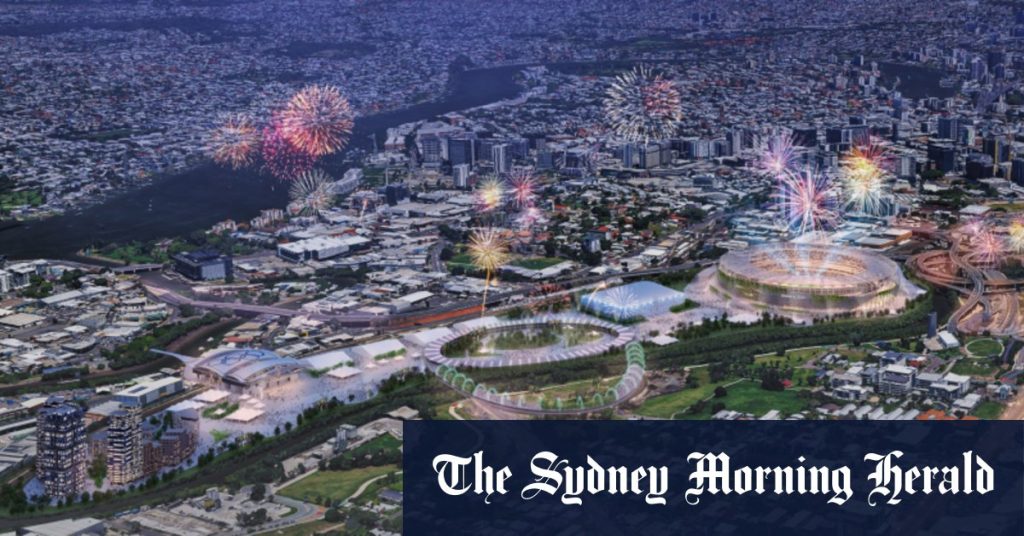Wilkinson Eyre, a multinational architecture firm renowned for its work on the London 2012 and Rio 2016 Olympics, has proposed a transformative vision for Brisbane’s 2032 Olympic infrastructure: the creation of a dedicated Olympic Park on the site of Queensland Rail’s Mayne Yard. This ambitious concept, submitted to both the Quirk and Crisafulli government reviews, aims to leverage the Games as a catalyst for urban regeneration, mirroring the firm’s holistic approach in previous Olympic projects. The 36-hectare Mayne Yard, a significant portion of the Bowen Hills area, currently serves as a stabling yard for QR rolling stock. Relocating this facility, while complex and costly, is deemed achievable and would unlock immense potential for the city.
The centerpiece of the proposed Olympic Park would be a 60,000-seat stadium, inspired by Perth’s Optus Stadium, strategically positioned at the southern end of the site near a major road interchange. A unique feature of this design is the integration of a warm-up track beneath the interchange, maximizing land use and creating a public amenity in an otherwise underutilized space. This innovative approach addresses the contentious issue of warm-up track placement, which plagued the Gabba rebuild proposal, by creatively utilizing existing infrastructure. The park would also include an indoor stadium, potentially demountable for post-Games flexibility, or a permanent structure if the planned Brisbane Arena at Roma Street proves unsuitable. This flexible approach allows for adaptation to evolving needs and provides a potential alternative to the controversial Roma Street arena project.
Wilkinson Eyre’s vision extends beyond sporting venues. It incorporates a new Breakfast Creek train station, seamlessly connecting to existing and future Cross River Rail lines, and featuring a bridge over the creek to improve access to Albion. An “Olympic Walk,” utilizing existing rail bridges, would enhance pedestrian connectivity across Enoggera Creek, linking the park to the surrounding areas. Furthermore, the northern portion of the site is earmarked for residential development, potentially extending towards the stadium after the Games, creating a vibrant, mixed-use precinct. This integrated approach aims to create a lasting legacy beyond the Games, contributing to the long-term development of the area.
The primary obstacle to realizing this vision is the critical operational function of the Mayne Yard. Wilkinson Eyre proposes relocating the facility to a site near Brisbane Airport, consolidating it with other major infrastructure hubs like the seaport. This relocation, while logistically challenging and potentially costly, would free up valuable inner-city land for the Olympic Park and other urban renewal initiatives. Centralizing these facilities would streamline operations and create a more efficient infrastructure network for the city. However, the tight timeframe for the 2032 Games presents a significant challenge to the feasibility of this relocation.
An alternative approach, building above the existing stabling yards, similar to New York City’s Hudson Yards development, is considered technically feasible but financially prohibitive. The cost of constructing a platform over the active rail lines and then building the stadium and other facilities on top would be exorbitant, potentially exceeding the already inflated budget of the Roma Street arena project. While this option offers a potential solution to the land constraint, the immense financial burden makes it unrealistic for Brisbane. Experts agree that while conceptually appealing, the cost of such an undertaking would likely outweigh the benefits.
Despite the challenges, the Mayne Yard proposal has garnered support, notably from former premier and lord mayor Campbell Newman. Newman, a vocal critic of building a new stadium on green space at Victoria Park, sees the Mayne Yard as a viable alternative, offering a transformative opportunity for the city. He argues that relocating the rail yard, while complex, is a worthwhile investment that would free up prime inner-city land for a stadium, other infrastructure, and urban renewal projects, potentially offsetting some of the costs. Newman advocates for a “hands-off” approach to Victoria Park and believes the Mayne Yard offers a chance to create a truly transformative project.
The Mayne Yard proposal presents a bold vision for Brisbane’s Olympic future, offering a compelling alternative to the contentious Gabba rebuild and the financially burdened Roma Street arena project. While the relocation of the rail yard presents a significant hurdle, the potential benefits of unlocking this valuable inner-city land are undeniable. The proposed Olympic Park, with its integrated stadium, indoor arena, transport connections, and residential development, could become a vibrant hub, leaving a lasting legacy for Brisbane beyond the 2032 Games. However, the feasibility of this ambitious plan hinges on overcoming the logistical and financial challenges associated with relocating the rail yard, and whether the political will exists to pursue this transformative vision. The debate continues as Brisbane grapples with the complex task of balancing the needs of the Games with the long-term development of the city.

